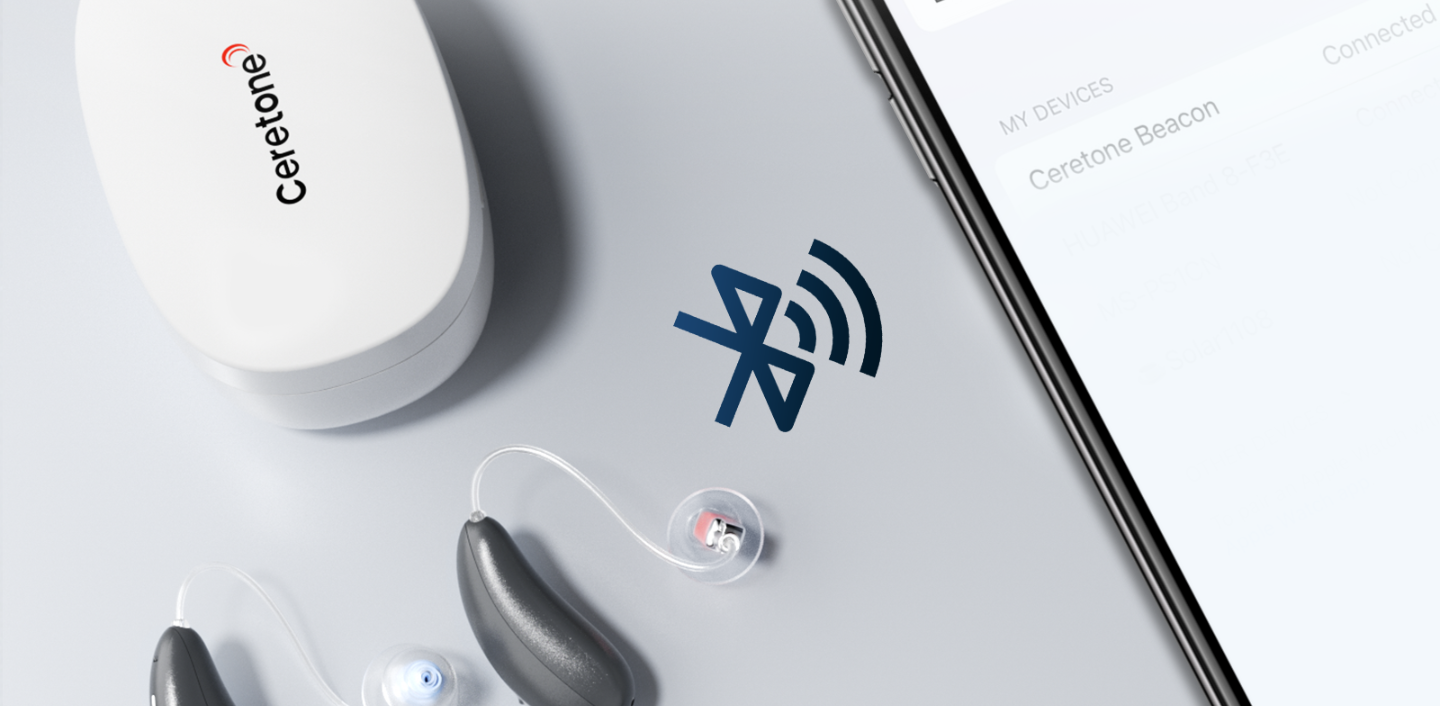
Bluetooth Hearing Aids: What You Need to Know & Buying Guide

The market for Bluetooth hearing aids is expected to almost double by 2031. That’s because many people who use hearing aids now want personalized hearing and audio streaming. But are all hearing aids with Bluetooth created equal? We explore how Bluetooth hearing aids work, plus how to pick the best one for you.
Table of contents:
- What Are Bluetooth Hearing Aids?
- How Do Bluetooth Hearing Aids Work?
- What to Look for in Bluetooth Hearing Aids?
- Best Bluetooth Hearing Aids in the Market
- Why Would You Need Bluetooth Hearing Aids?
- How to Connect Hearing Aids to Bluetooth?
- How Much Are Bluetooth Hearing Aids?
- Check Out Beacon Bluetooth Hearing Aids Today
What Are Bluetooth Hearing Aids?
Bluetooth hearing aids connect to other devices via Bluetooth to stream audio directly into the ear. They allow you to easily stream calls on your smartphone and listen to your favorite podcasts and shows. Bluetooth hearing aids are available for all degrees of hearing loss, from mild to severe.
How Do Bluetooth Hearing Aids Work?
Bluetooth hearing aids connect wirelessly to other devices using the Bluetooth technology.
Bluetooth is a data transfer protocol invented by Jaap Haartsen in 1994. It allows two devices to transfer data between them without a wire connection. The devices pair up and send data over short-range radio waves that cover up to 30 feet.
Stylish hearing aids with Bluetooth use different protocols to connect to other types of devices. For instance, Bluetooth hearing aids connect with Android devices via the ASHA (Audio Streaming for Hearing Aids) protocol, while iPhones use MFI (Made for iPhones). All Android devices of at least OS version 11 support ASHA, while most iPhones from iPhone 6 and above can connect with MFI hearing aids.
Some hearing aids can also be connected to other wireless devices, such as smart TVs, GPS systems, and MP3 players.
What to Look for in Bluetooth Hearing Aids?

Aside from the fact that Bluetooth hearing aids can help all degrees of hearing loss, here are other factors to consider when picking out a pair of Bluetooth hearing aids for you:
Range of Devices They Pair With
Some hearing aids are specifically made for iPhones, meaning they can’t connect to Android devices. As for smart TVs, most Bluetooth hearing aids connect automatically if the TV is Bluetooth-enabled. If not, some hearing aids have special TV streamers that act as middle devices between the TVs and the hearing aids.
Length (In Feet) of Connectivity
Bluetooth can’t support connections for very long distances because it uses short-range radio waves. However, the longer the distance your hearing aid can support, the better. For example, you can connect to your smart TV and still walk around a small apartment without the connection being dropped.
Media Streaming — Calls, Music, and Video
Some hearing aids are better for listening to phone calls, while others are optimized for audio. Confirm the types of media a Bluetooth hearing aid is optimized for to ensure you’re getting one that matches your preferences.
Bluetooth Hearing Aid App Guide
Some Bluetooth hearing aids have mobile apps for easy remote controls and personalized hearing. Even though you don’t use the apps to connect to Bluetooth, they allow you to easily self-tune your hearing aids for different settings.
Best Bluetooth Hearing Aids in the Market
Are you looking to get Bluetooth hearing aids that are perfect for you? We compared the top industry-leading Bluetooth hearing aids in the market, including what users say about them and their pros and cons.
Ceretone Beacon – Best Self-fitting Bluetooth Hearing Aids
Ceretone Beacon RIC hearing aids are the best-value self-fitting hearing aids with Bluetooth in the market now. They’re over-the-counter FDA-registered hearing aids optimized for mild to moderate hearing loss.
Beacon comes with the latest Bluetooth 5.0 technology, optimized for hands-free phone calls, music, and TV streaming. Even better, it supports both Android and iPhone devices. Also, Beacon has a mobile Ceretone app with an in-built hearing test, which allows you to fully personalize and tune your hearing.
Furthermore, Beacon hearing aids have professional-grade digital chips that offer advanced features like background noise reduction and feedback suppression. The Bluetooth hearing aids also have four hearing presets for indoor, outdoor, restaurant, and music-listening modes.
What users say
Over 90% of Beacon users rate the hearing aids a 5 out of 5. Here are some things they had to say:
John says, “I had been using prescription hearing aids for the past 6+ years. I have been using my Ceretone hearing aids for the past two weeks. So far I am very pleased. Much more cost effective over prescription hearing aids.”
According to Malachi, “I totally think Beacon hearing aids are the bomb when it comes to bang for your buck! They've been super helpful for me. I can rock them for three days on a single charge, and they're so comfy to wear. Plus, I can use them as Bluetooth earbuds to jam out to tunes and watch videos, which is just mind-blowing for me.”
Beacon Pros and Cons
|
Pros |
Cons |
|
Ceretone Beacon supports both Android and iPhone devices. |
They’re not optimal for severe hearing loss. |
|
They last up to 15 hours with a rechargeable case that provides an additional 45 hours of usage. |
|
|
You can connect to smart TVs with Ceretone Beacon. |
|
|
The RIC design is comfortable and provides clear and natural sounds. |
|
|
They support four preset hearing modes. |
|
|
They come with a hearing test to help you tune them yourself. |
|
|
They're IP65 waterproof. |
All in all
Ceretone Beacon is one of the most affordable Bluetooth hearing aids on the market at only $599. Even better, there's no risk to getting a pair of Beacon hearing aids because you can return them within 60 days, and they have a one-year warranty.
Lexie B2 Hearing Aids vs. Ceretone Beacon: Why Pay More for Less?
Ceretone Beacon vs Sennheiser All-Day Clear - RIC Hearing Aid Reviews
[Get Ceretone Beacon Bluetooth Hearing Aids Today]
Resound NEXIA — Best for Advanced Features

Resound NEXIA is a prescription-grade RIC-style Bluetooth hearing aid. It's not over-the-counter, so you must get it from an audiologist.
However, the hearing aid is famous for excellent background noise reduction. It also provides up to 30 hours of battery life on a single charge. However, there’s no rechargeable case.
Still, NEXIA offers Auracast, an advanced Bluetooth feature that lets you access direct audio sources in public places. For instance, you can connect with the speakers in a movie theatre to have the audio transmitted directly to you.
What users say
NEXIA users love the RIC design because it's comfortable. Although some users found the hearing aids too loud at first, they quickly adjusted to them.
NEXIA Pros and Cons
|
Pros |
Cons |
|
Resound NEXIA works for mild to severe hearing loss |
They’re overly expensive compared to other options |
|
They support Auracast technology for public use |
They aren’t over-the-counter, so they are not easy to obtain |
|
They’re compatible with both Androids and iPhones |
|
|
They can stream phone calls, music, and videos. |
|
|
They provide up to 30 hours on a single charge. |
All in all…
Resound Nexia Bluetooth hearing aids start at $3,198 and go up to $3,998. Even though they’re expensive, they’re still one of the best options available if you want premium prescription Bluetooth hearing aids.
Lexie B2 Plus Powered by Bose — Best for Call Streaming

Lexie B2 plus are OTC Bluetooth hearing aids for mild to moderate hearing loss. Like Ceretone Beacon, they come with preset hearing modes and a hearing test for self-fitting.
The hearing aids support both Android and iPhones for great hands-free call streaming. However, they're not optimal for streaming music or other types of media.
If you can look past that, the Lexie B2 offers advanced features like bidirectional microphones. It also works for up to 18 hours on a single charge and has a rechargeable case.
What users say
Users love that others hardly notice the Lexie B2 plus hearing aids because of their small size, regardless of the RIC style. That said, some Android users complained that connections dropped frequently.
Lexie B2 Plus Pros and Cons
|
Pros |
Cons |
|
Perfect for hands-free call streaming |
It doesn't work for severe hearing loss |
|
Supports both Android and iOS devices |
They aren’t optimized for music and video streaming |
|
It has bidirectional microphones for hearing in very noisy places |
Is more expensive than Ceretone Beacon |
|
Last up to 18 hours on a single charge |
All in all…
Lexie B2 plus hearing aids cost $999, which may be too much if you're looking for affordable options.
Why Would You Need Bluetooth Hearing Aids?

Over 80% of hearing aids are wireless, with most supporting Bluetooth. Here are some reasons why they’re so popular:
- Bluetooth hearing aids support hands-free call streaming.
- They allow direct media streaming from other wireless devices like smartphones, smart TVs, and MP3 players.
- They allow for easy remote controls via mobile apps.
- OTC Bluetooth hearing aids usually have built-in hearing tests.
- Bluetooth hearing aids will enable you to personalize and self-tune your hearing.
- They can be alternatives to headphones.
How to Connect Hearing Aids to Bluetooth?
The steps to connect your hearing aid are similar for Android and iPhone. However, there are separate detailed step-by-step instructions.
How to Connect Your Hearing Aids to an Android Phone?
Follow these steps to connect your Bluetooth hearing aids to an Android device.
- Remove your hearing aids from their case.
- Open “Settings” on your Android phone.
- Go to “Connections.”
- Click on “Bluetooth” to turn it on. It automatically begins to scan for nearby devices.
- Once the name of your hearing aid pops up, click on it to pair.
- Click “Pair” to confirm.
How to Connect Your Hearing Aids to an iPhone?
These are the steps to follow to connect your Bluetooth hearing aids to an iPhone:
- Remove your hearing aids from their case.
- Open “Settings” on your iPhone.
- Click on “Bluetooth” and allow it to scan.
- Select the name of your hearing aid to pair.
How Much Are Bluetooth Hearing Aids?
Prescription Bluetooth hearing aids cost at least $1,000, with some costing as much as $4,000. However, the best OTC hearing aids are much more affordable. For instance, Ceretone's Beacon costs only $599 per pair.
Check Out Beacon Bluetooth Hearing Aids Today
Bluetooth hearing aids are very popular because they enhance hearing while providing advanced features. However, they can also be costly, with some brands costing up to $4,000.
Luckily, Ceretone Beacon is a super-affordable Bluetooth hearing aid for people with mild to moderate hearing loss. Beacon supports many devices and provides up to 60 hours of continuous usage.
The best part is that they cost only $599, have a 60-day return window, and have a one-year warranty. Why don't you check them out today?









